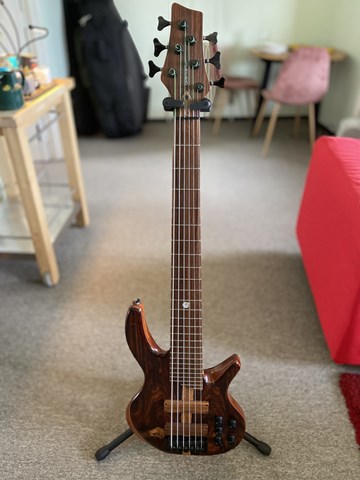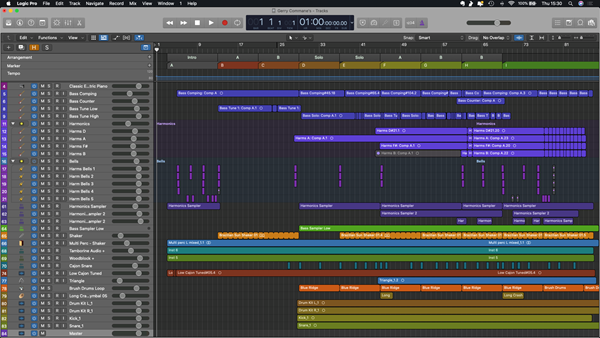Gerry Commane's - Commentary
Contextualisation
Gerry Commane's, also known as Gearoid Ó Comain or Gerdy Commane's is a 32 bar, 4/4, AABB Irish Reel tune in D Major. A 'Reel' in traditional folk music is associated with a style for dancing, as is most forms of traditional folk music.
(This video is a work in progress)
Typical characteristics of a reel include:
- 4/4 or 2/2 Time Signature
- Predominately 8th note melody
- AABB form, 32 bars
- Part of a 'set' of tunes of varying styles
The first digitised recording that can be found of this piece is by the highly influential Irish tin whistle player Mary Bergin on her 1979 record 'Feadoga Stain'. Bergin is believed to be the composer of the tune** although definitive information is difficult to find.
The tune features in a set of tunes titled: "Rileanna (Reels): Bean Ui Chroidheain (Mrs. Crehan's) / Gearoid O Comain (Gerry Commane's) / An La Baisti (The Rainy Day)". Gerry Commanes begins at 0:48 and ends at 1:52.
I originally discovered this tune from the album Midnight by the ensemble May Monday, of which British folk musician and accordion extraordinaire Karen Tweed joins with Finnish folk composer/musician Timo Alakotila. Their rendition of this tune forms part of a colossal set of 5 tunes, some traditional, others original. I was introduced to the recording when I was lucky enough to work with Karen Tweed back in 2008/9 when this album was newly released.
In their arrangement, Gerry Commane's comes out of a much slower tune called "Hope" in F major (98 bpm) which by 3:44 has modulated to G Mixolydian and accelerated to 118 bpm into an introductory melodic passage before a soli rendition of the first A. The rest of the arrangement grows excellently with the ensemble carrying the rest of the tune in a driving and graceful manner supported by stylistically appropriate harmonic choices that subtly point towards complex understanding of reharmonisation methods.
This album is not available for online streaming but can be found here
My Challenge
I wanted to once again take a different approach and challenge myself to play both the melody and accompaniment. I decided to use a single instrument, my custom 6-string Overwater Progress 3 bass. Its extended range (4 octaves + minor 3rd), plus the use of natural and false harmonics, would allow for the majority of the sonic spectrum to be utilised though melody and harmonic accompaniment. I secondly decided to have untuned percussion to compliment this.
I didn't have a solidified idea how this piece was going to develop when I started. Most of the decisions were dependant on the previous explorations.
As it is generally surmised in most genres, the tune/melody is deemed at the top of the musical hierarchy, a global assumption I would challenge, but that is another discussion altogether. In the folk world however, this sentiment is very much true. Tune players in a session would typically call the next tune, begin playing and set the tempo before others join in. Accompaniment players are expected to pick up on tempo fluctuations and changes dictated during performance. So, starting with the tune seemed a good place to commence my exploration.
Tempo soon became an important decision to pin down. In learning the tune from the May Monday transcription and speed adjustment software I was unsure where to place it. The piece suits moderately faster tempos, as reels generally do, and so I began to create a Logic project with the same tempo as the May Monday recording. Somehow the tune on bass felt too rushed and cumbersome, perhaps due to the slightly tricky nature of the tune when applied to the bass due to the numerous string crossing/jumping moments that are difficult to recreate at speed. But also, this was the subsequent piece after Watermans, which was at a tempo right on the limit of my technical ability, because of this, I wanted a slightly easier ride, and during practice I had come up with a loop version of the tune with a tempo and groove that felt more natural albiet far too slow for a traditional reel. I settled with 95 bpm, which makes this the slowest rendition of this tune that I could find. Reels tend to be performed between 100-130 bpm depending on the context, i.e. for dancing or not.
In this video which is the final part of a practice session exploring ways of approaching playing the tune and generating an accompaniment. Here I had begun to settle on the slower tempo, this is at 90bpm and had borrowed the harmony from one part of the May Monday recording for the A section:
||D D/F# | G A | Bm F#m | G A/C# |
| D D/F# | G Bbo7 | Bm F#m | G A/C# ||
Then for the B section I chose a dominant pedal to complete the loop.
|| A | Bm/A | A | A6 |
| A | Bm/A | A | G A/C# ||
This video also demonstrates a brief attempt to blend the original melody with a short burst of improvisation. There is scope here for exploring how improvisation around a folk melody on the bass guitar would work which I will discuss my approach to shortly.
The Arrangement - Overwater Bass
Much of the harmony for the full arrangement stayed the same as in the looping video with the exception of omitting the dominant pedal from the B section and instead keeping the same harmonic structure throughout the piece. At this point in developing the piece I felt the dominant pedal took too much momentum out from under the expression of the melody.
The Overwater bass allows for convincing chordal playing due to the larger intervallic range available in the higher positions. Most of the main accompaniment part was constructed this way, using 10th intervals between the bass line and harmony notes and developing to additional voices above that. This initial interval of a 10th creates good separation between bass-line and harmony. The thickest the bass accompaniment comes in the form of the G6 chord in the introduction and coda. This voices G6 as G1, D2, E2, B2 (Root, 5th, 6th, 3rd) and G6#11 as G1, C#2, E2, B2 (Root, #11, 6th, 3rd). This use of a tri-tone in this register is risky, verging on the range limit of what could be deemed effective chordal accompaniment for the electric bass.
As mentioned, in order to utilise the 10ths and upper voices in the bass voicings it did mean that I was unable to fully utilise the lower extended rand of the bass. Here I opted to use the keyboard sampler (discussed briefly later), to create sub-bass tones from the sampled harmonics. This was the final part to be added to the piece and added the missing weight the track needed and leads to the question of to what extent do we need to hear some sort of dedicated low register 'bass-line' in order to feel coherence in a track? For all its simplicity, this part added huge value and impact to the piece, lifting it after the solo section.
Rhythm and Percussion was provided by Brendan Bache who can be seen and heard as the percussionist Second Circle's first piece Watermans. Here Brendan was given little direction in terms of percussion parts. Only that it needed a heavy snare on the back beat, but used with brushes instead of sticks. The drum kit part is distinctly dissimilar to the drum groove used in the looping video partly due to it sounding too heavy for the full but rather gentle harmonic timbre supporting the melody. Brendan's part was inspired by the secondary Logic drum loop, I used as a basis for recording to.
After the main body of the bass arrangement was complete a question arose. How much sonic space could I continue to utilise using the bass?
I began experimenting with natural and false harmonics with dense reverbs to create high-pitched bell-like effects.
This idea I developed further into an full part for the track, stacking these harmonics to create subtle harmonic movement whilst utilising common tones as much possible.
The "Keyboard" Part
Taking the use and idea of harmonics a step further still,I had the idea to incorporate them into a sampler. In effect, creating a chromatic keyboard of sampled bass tones over 3 octaves with harmonics.
From this, with the additions of some delay and reverbs the following sounds were created and used to further pad out the middle range of the track.
Towards the end of the piece (2:57 - 3: 03) I felt it was appropriate to add a quote from the May Monday track. this phrase features as the introductory phrase in-between tunes before May Monday perform Gerry Commane's proper (3:41 on the May Monday track).
The combined effect of the harmonics, 'bells', and sampler creates an interesting texture within higher registers that could in future provide a unique solution to providing bass generated accompaniment to a lower range bass-line melody part.
The 'Solo' Section
Taking a general idea from the jazz idiom, there is a solo section for the bass to improvise sandwiched in-between performances of the tune, although typically in jazz an AB tune is only played once at the beginning and once at the end after solos. In this solo section I had originally thought and expected the solo melody would draw heavily upon the melodic material within the tune itself, but what actually occurred was almost the opposite. In the earlier looping video I attempted at this at 1:10 - 1:51, was had been practicing transitioning from melody to improvised melody at different moments.
I had implemented a practice process for the purposes of developing a 'connection' to improvised lines. A way to practice playing what the ear and innate creativity wants to play rather than what ones hands might often dictate to us through the practice and automatic nature of playing. This is something I have struggled with and will continue to develop further, but for the purposes of this commentary the practice basically consisted of:
- Playing the backing
- Listening for an idea
- Transcribing that idea onto the bass with out losing its essence
- Being aware of when the hands 'take over'
- Being aware of when a typical 'fall-back' phrase
- Repeat and listen for the next fragment
A couple of hours with this process and the solo melody was complete. This composed melody felt much more coherent to what I could call my musical voice than what I could have improvised on the spot.
To clarify a couple of above terms, by "take over" I mean the process of "falling-back" into the habitual ways of playing/improvising as a means of getting through a passage or moment where we don't know what to do. These might be licks or patterns that are essentially stand-alone drag and drop elements of improvisation. This way I feel is limiting, and it was my hope that this practice would help to break through that to what improvisers like Kenny Werner and Mike Walker refer to as 'your individual song'. This song, was something much slower in phrasing and pace than I had anticipated. With the relentless 8th notes of the melody I had assumed the solo would occur similarly, again much like in jazz bebop, where tunes based around 8th notes are the launching-off point for improvisations. The piece felt like it needed space to breathe, to slow down some what and take a respite before commencing the tune again.
Thank you for reading. If you have any questions or comments please feel free to get in touch.
**According to (https://tunearch.org/wiki/Gerry_Commane%27s_Reel)
- http://www.timoalakotila.com
- https://en.wikipedia.org/wiki/Timo_Alakotila
- https://en.wikipedia.org/wiki/Reel_(dance)
- https://tunearch.org/wiki/Annotation:Gerry_Commane%27s_Reel
- https://www.irishtune.info/tune/715/
- http://www.traditionalmusic.co.uk/folk-music-mandolin-tab/gerry_commanes.htm
- https://www.cbfiddle.com/rx/tune/t2434.html
- https://tunearch.org/wiki/Gerry_Commane%27s_Reel
Purchase Midnight by May Monday: https://www.karentweed.com/product/midnight-may-monday-2/
Posted In: Reflections on Practice
Tagged: Folk Tune, Looping, PaR, Second Circle
← Back to Recent Posts


